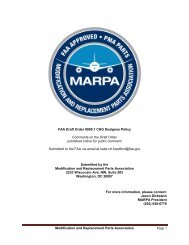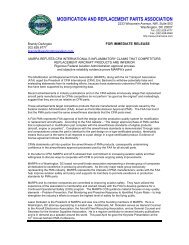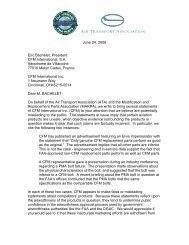Comments - MARPA
Comments - MARPA
Comments - MARPA
You also want an ePaper? Increase the reach of your titles
YUMPU automatically turns print PDFs into web optimized ePapers that Google loves.
Second, the disparity between repair stations that are able to change their own capabilities lists<br />
as opposed to those repair stations that must seek FAA approval may effectively limit the<br />
number of repair stations that add PMA parts to their capability list. A repair station able to selfaudit<br />
may be inclined to use an equivalent PMA part in order to recognize the quality and costsavings<br />
benefits of PMA. A repair station that must seek FAA approval, however, may be<br />
unwilling or unable to dedicate the resources to applying for approval to the change in their<br />
capability list to add that PMA part. Such repair stations are therefore eliminated as customers<br />
of the PMA industry, increasing costs without an associated safety benefit.<br />
Third, FAA Flight Standards employees complain that they do not have the resources to<br />
accomplish what they need to accomplish under current standards. Without the resources to<br />
undertake this new and significant burden, the FAA likely will be unable to process and return<br />
capabilities list changes in a timely manner, so this will become one more drag on the industry<br />
that inhibits economic growth. This again negatively affects the PMA industry, as new PMA part<br />
could not be used by a repair station until the update capability list was approved.<br />
Fourth, for those repair stations that are not authorized to make changes to their capabilities<br />
lists, in addition to the required review of the list, a substantial burden is imposed. Some repair<br />
stations list as many as 30,000 capabilities. Maintaining such a list may necessitate a full time<br />
employee for that exclusive purpose. This would be fundamentally unfair when these repair<br />
stations have to compete against other repair stations that are permitted to change their own<br />
operations specifications.<br />
The proposed regulation also requires a review of a repair station’s capability list every two<br />
years to determine upon which articles the repair station is still capable of performing<br />
maintenance. Because of the business cycles of the industry, it is possible for a repair station to<br />
go several years without seeing a particular component, and then see that component<br />
repeatedly after a hiatus. During the hiatus, the capability to perform the work may lapse<br />
because it is not central to the repair station’s business model. But it is normal practice for a<br />
repair station to self-audit current capability when they get a component in for repair. Thus, it is<br />
normal practice for a repair station, when they recognize that their resources are inadequate, to<br />
take steps to make them adequate before beginning work. For example, because of the high<br />
costs of maintenance data, a repair station may allow a subscription to lapse while no work for<br />
that component is coming in. But when the repair station gets that component in for<br />
maintenance, it will obtain the appropriate version of the manual from the customer or from<br />
another source (obtaining maintenance data from the operator has been specifically recognized<br />
as a valid practice in guidance like FAA Order 8110.54A, and as a practical matter competitive<br />
limits imposed by design approval holders often make this a de facto mandatory way to obtain<br />
maintenance data).<br />
That same repair station may also find that it needs certain parts to perform necessary<br />
maintenance. It may not continuously stock certain parts due to the costs of warehousing parts<br />
that may not be immediately needed. When, after a delay, the repair station begins performing<br />
maintenance on a certain component, the repair station may seek PMA parts to keep costs low<br />
Modification and Replacement Parts Association Page 14








